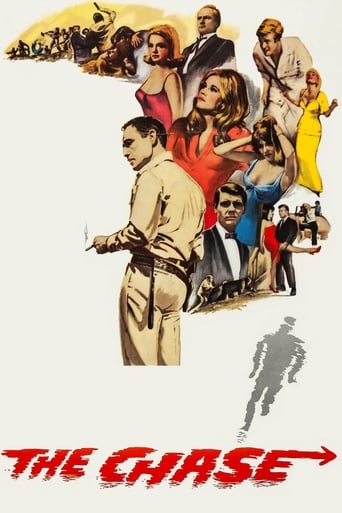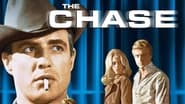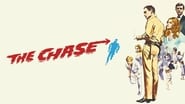StrictlyConfidential
(*Movie quote that set the tone of this film's story*) - "Let white man take care of white man's troubles!"Out of The Chase's total running time of 135 minutes - I'd say that its dreary, small-town, soap opera story only rose above that mediocrity for about 10 of those many minutes. It's true.Marlon Brando's irksome, phone-in performance aside - Am I the only one who got so sick to death of hearing the name "Bubber" being spoken by just about everyone (and their dog) in the horrid, little town of Tarl, Texas? Eh? Am I!?And, speaking about "Bubber" - IMO - Only a babbling idiot (which I guess "Bubber" was) would head straight back to his hometown after breaking out of prison. Like - DUH!!??All-in-all - 1966's The Chase was total brain-dead idiocy from start to finish.
Wuchak
RELEASED IN 1966 and directed by Arthur Penn, "The Chase" details events in an East Texas town (think Beaumont, TX) when Bubber Reeves (Robert Redford) escapes from prison and how this affects the populace. Marlon Brando plays the sheriff who tries to track down Bubber's whereabouts while Angie Dickinson is on hand as his supportive wife. Jane Fonda plays Bubber's ex-girlfriend and James Fox her secret beau. Janice Rule appears as a drunken woman of dubious morality, Robert Duvall her hubby and Richard Bradford one of the men with whom she cheats. E.G. Marshall is on hand as the town mogul. Look for a young Paul Williams as one of the partying teens (he's easy to spot). "The Chase" is mid-60's Southern Gothic in the manner of "The Fugitive Kind" (1960), "In the Heat of the Night" (1967), "Cape Fear" (1962), "This Property Is Condemned" (1966) and "The Long, Hot Summer" (1958). It's arguably on par with most of these, but is significantly superior to the last one. The first act is weak as it establishes the characters, but the story becomes captivating starting with the second act and the surreal drunken party at the mogul's mansion (and the teens in a neighboring abode). Imagine if "Village of the Giants" (1965) was shot as a serious melodrama, minus the giants, and that's the general vibe. The movie addresses elements of hedonistic revelry, racism, sexual revolution (several of the players are involved in affairs), political corruption (the sheriff is wrongly thought to be bought by the mogul), and vigilante non-justice. The most iconic scene is when the sole voice of reason is viciously beaten by the character played by Bradford, along with his buds. Marlon later cited this as an example of his renowned Method approach. The wild last act in an auto graveyard is also iconic.Despite the picture's many strengths, it's too meandering and unfocused to be wholly effective, as was Penn's great "Bonnie and Clyde" (1967). But you can't beat the cast, especially Brando. THE FILM RUNS 2 hours and 13 minutes and was shot in California (Calabasas, Chico, Agoura & Burbank studios). WRITERS: Horton Foote (play) & Lillian Hellman (script). GRADE: B/B- (6.5/10)
Mark Turner
Imagine if you had the following line up in a film: Marlon Brando, Robert Redford, Jane Fonda, E.G. Marshall, Angie Dickinson and Robert Duvall. This film did indeed have that cast. In addition to that the film was written by Lillian Helmond based on the book and play by Horton Foote and directed by Arthur Penn who would direct BONNIE AND CLYDE the following year. With all that talent combined why isn't this film more well-known or discussed? A lot of that could be due to the story itself. The base of the story does seem interesting but the way it's handled here, major talent involved in its writing or not, it plays more like a soap opera than an action film which was how it was marketed. A great trailer can make a movie but if you don't deliver what you promise an audience will remember.The story revolves around a small Texas town that is run by and basically owned by the Rogers family. Convict Charlie "Bubber" Reeves (Redford) has escaped with another con and is heading for Mexico. His partner kills a man, steals his car and leaves Bubber to fend for himself.Back in town Val Rogers (Marshall) is about to celebrate his 60th birthday. The employees at the bank toast him while the wife of milquetoast and bank VP Edwin Stewart (Duvall) watches as his flirtatious wife Emily (Janice Rule) confronts Val about why she and her husband are never invited to his parties. Emily is the catalyst for much that happens in the film, a woman intent of stirring the pot, having an affair with Edwin's married co-worker Damon (Richard Bradford) and spending as much time with a bottle as a person can without passing out.Val's son has his own situation to deal with. Unhappily married for the sake of his father, Jake (James Fox) has been having an affair with Anna (Fonda), the wife of Bubber. The entire town, with the exception of his father, is well aware of the affair but no one speaks up.In the middle of all of this is the local Sheriff Calder (Brando). Living in his office above the jail with his wife Ruby (Dickinson) Calder is intent on doing his job. The job was given to him by Val and for that reason many who are considered a class beneath Val look unfavorably on Calder, seeing him as a hired hand rather than a lawman. What they don't realize is that Calder is indeed a man of integrity, a man whose soul will be eaten by both classes before the end of the film.More time is spent with the whole set up of the town, a dissection of the characters who make up this city and its various classes. There is the upper crust, donating millions to the building of a college Val has high hopes for. There is the middle class, the hard partying drinking revelers on a Saturday night who resent the Rogers family while working for them none the less. There are the blacks in the town who, being in the mid-sixties still, now have rights but rarely have anyone to defend those rights for them. And finally there are the teens, bound and determined to follow in the footsteps of their parents, hard partying and drinking all the way.The ins and outs of these groups, who is sleeping with whom, develop more tension than the chase for Bubber. In thinking back we get a better glimpse of these people, their lives and their interactions than we do Bubber. Eventually Bubber is given a chance to speak about the injustices of this town and the people in it, but that's more of a speech than character development.As various members of the town get drunker as the night goes on, as their resentments begin to surface thanks to the alcohol, tension builds and confrontations begin. Calder is assaulted by a group of Rogers's employees, not because they want to help their boss but because they resent him. Beaten and bloody he still attempts to find and save Bubber before this group can get their hands on him.In watching the movie it was entertaining enough but felt too long to reach the end. Brando gives a decent performance, Redford does what he can with the part, Fonda isn't on screen nearly as much as you would expect and no one really stands out. Reading about the film later I discovered that the story had failed as a book and play and the movie didn't fare much better when it was released. Producer Sam Spiegel wanted a message movie, director Penn wanted a more straight forward approach and in the end Spiegel took over and cut the film the way he wanted. Penn eventually disowned the film. Hellman, who was friends with Penn, blamed him for the way it turned out and the two parted on bad terms.Fans of the actors involved or of Penn will want to check the film out just to see how they do here. If you like movies like PEYTON PLACE then you'll find plenty to enjoy. But for most it will not be a fan favorite. The movie is being released by Twilight Time so the usual applies here, limited number of copies and few extras but a glorious looking print involved.
dougdoepke
Despite the talent in front of the camera and behind, the movie amounts to a swollen mess. The script utterly fails in character development, settling instead for brief snatches. As another reviewer points out, there are no close-ups to reveal inner feelings or to ease our identifying the person. The latter is especially troublesome since so many scenes unfold in half-light. Awkward staging doesn't help either, especially the ridiculous crowd scenes, where women flaunt wantonly and men stand drunkenly by. The upper-class decadence is spread on with a shovel.This may have been cutting-edge in 1966, but now it's not only woefully overdone, but plain silly too. Then there's that climactic scene from junkyard hell where our nose gets rubbed in flaming tires. It may provide cinematic spectacle but otherwise adds only to the exaggeration. It's also too bad that a hundred lesser actors could have filled Brando's role, about which he appears understandably detached. At the same time, Dickinson's role as Brando's wife looks like a wasted add-on. Plus, the flaunting slut has got to be the nadir of Janice Rule's otherwise distinguished career. Among the principals, only Redford and Marshall come through unscathed.One interesting note not emphasized in the script-- just what is Bubba's (Redford) crime, deserving of the ending. Looks to me like a tragic occurrence that otherwise goes unexplored. I wish there were something really redeeming about this mess, perhaps that its heart is in the right place racially. But there really isn't much redemptive. Too bad such a fine cast is largely wasted, while the supposed look at Southern decadence amounts more to unfunny parody than anything thoughtful. One positive note-- I'm glad director Penn's career managed a quick recovery from what could have been an industry graveyard. All in all, whatever the offscreen production squabbles, which I guess were real, they sure didn't help what ended up on screen.










